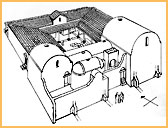|
Philippi: a major episcopal centre
Philippi in Thrace, midway between Thessalonika
and Constantinople,  was
one of the major Christian centres in the Aegean. A vast episcopal
centre, it featured a number of churches, as well as residential
and administrative quarters, clustered around the so-called
Octagon (c. 500), the cathedral church of Philippi. The splendid
Basilica A (c. 500) was reached through a series of courtyards
and nartheces. Basilica B, of the
transept domed
type, was erected shortly before 540. Philippi had an active
community of artisans involved in the decoration of its churches.
Much of the carved structural elements of the buildings is
of local manufacture. Numerous coloured glass fragments and
lead strips, identified as debris of stained glass panels
used in apse windows, have been discovered in the episcopal
residence, the Octagon, the extra-mural basilica and Basilica
C. The finds date from the sixth century and can be related
to the discovery of a small glass workshop in the remains
of a Roman building in the south of the city. The same building
also housed a metal workshop, identified by casting scraps,
slag, bronze weights, numerous nails and knives. was
one of the major Christian centres in the Aegean. A vast episcopal
centre, it featured a number of churches, as well as residential
and administrative quarters, clustered around the so-called
Octagon (c. 500), the cathedral church of Philippi. The splendid
Basilica A (c. 500) was reached through a series of courtyards
and nartheces. Basilica B, of the
transept domed
type, was erected shortly before 540. Philippi had an active
community of artisans involved in the decoration of its churches.
Much of the carved structural elements of the buildings is
of local manufacture. Numerous coloured glass fragments and
lead strips, identified as debris of stained glass panels
used in apse windows, have been discovered in the episcopal
residence, the Octagon, the extra-mural basilica and Basilica
C. The finds date from the sixth century and can be related
to the discovery of a small glass workshop in the remains
of a Roman building in the south of the city. The same building
also housed a metal workshop, identified by casting scraps,
slag, bronze weights, numerous nails and knives.
In the immediate vicinity of the Octagon, to the north
of the
baptistery,
lay a Roman bathing establishment, which was later included
in the church complex and was thus probably administrated
by the church. One entered the baths through a colonnaded
court. To the right of the vestibule, in the north wing, was
the keeper's logde, followed by a changing room and an chamber
for annointing. To the left, were a washing room and lavatory.
A secondary entrance in the west wall of the complex also
led onto the court; opposite, lay the cold bath (frigidarium).
The south wing of the bathing complex was occupied by the
hot and tepid baths (caldarium and tepidarium), the substructure
of which is dotted with brick supports allowing the circulation
of hot air, firechambers and rooms of unknown function. In
the middle of the sixth century, the tepidarium was divided
into two separate rooms for simultaneous use by both sexes;
consequently, a firechamber room was added.
|